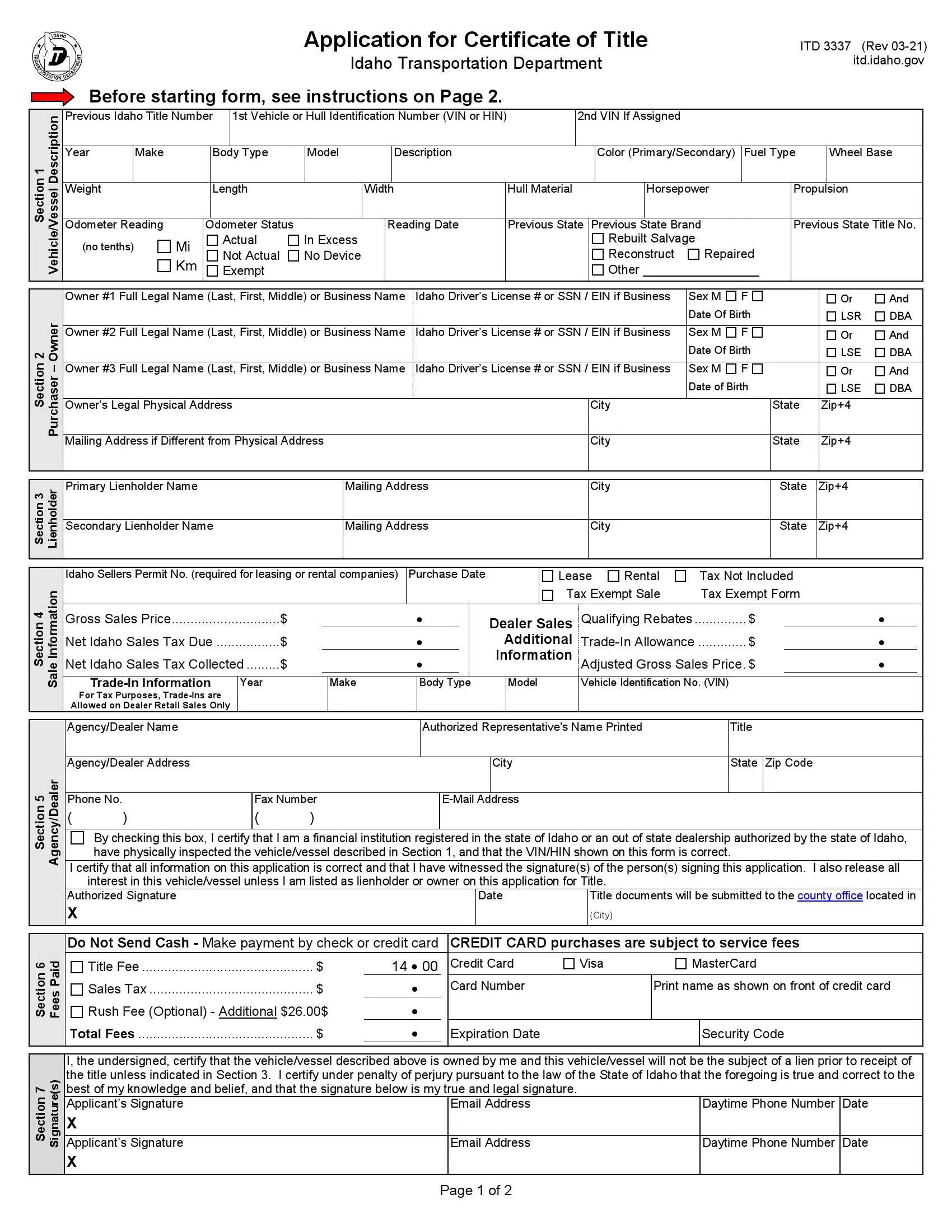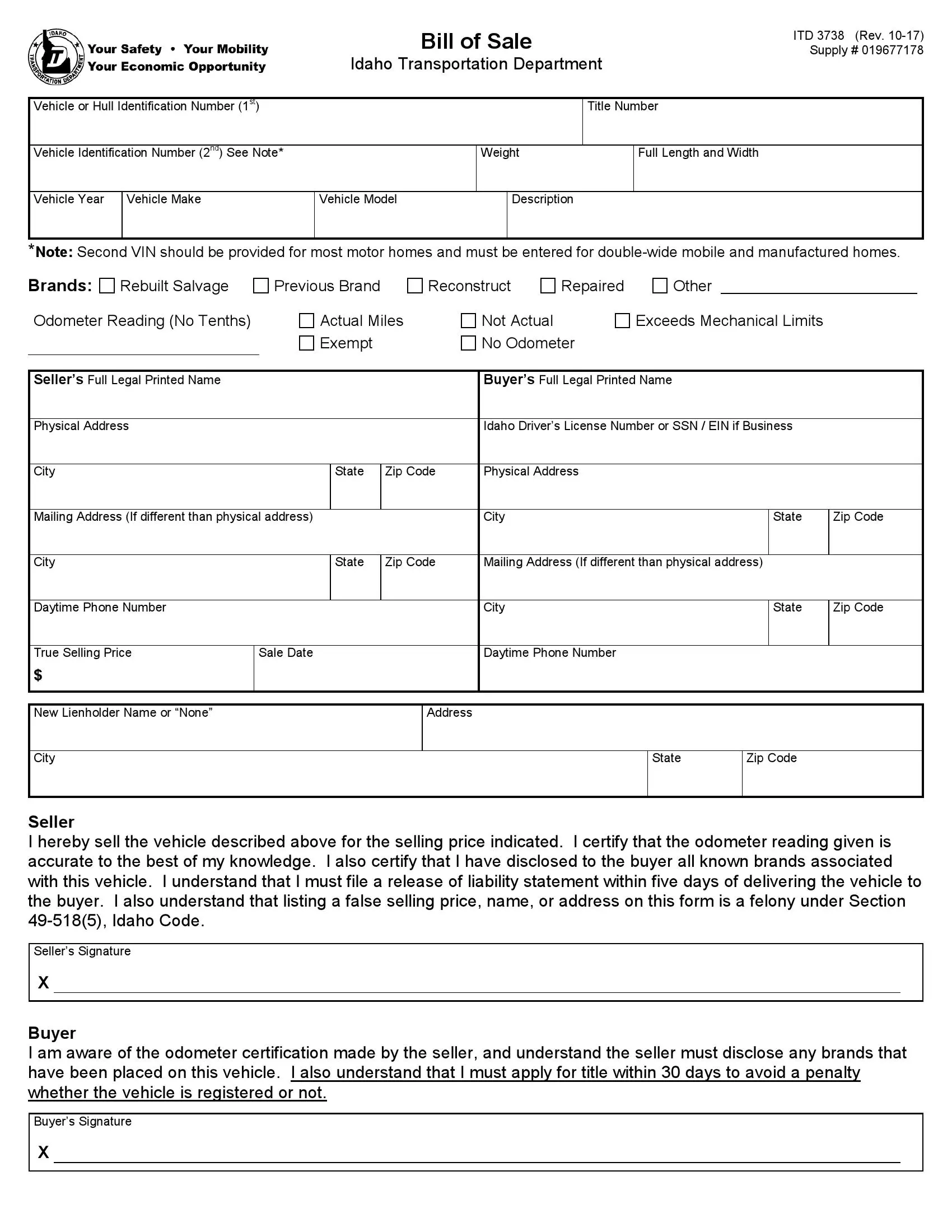Idaho Bill of Sale Form
Idaho bill of sale is a form, official or customized, to be used during the private sale between two parties. The Idaho law doesn’t require notarizing or witnessing the form. Still, it has legal power as proof of transaction and is present in official institutions for ownership transfer or registration of a new vehicle.
We have created different types of bills of sale that can be used during the sale of motor vehicles, boats, pieces of art, or any other property. You can choose a predefined template and download it from the site or fill in an official Idaho form, ITD 3738, from the Department of Transportation if you need to sell or buy a vehicle.
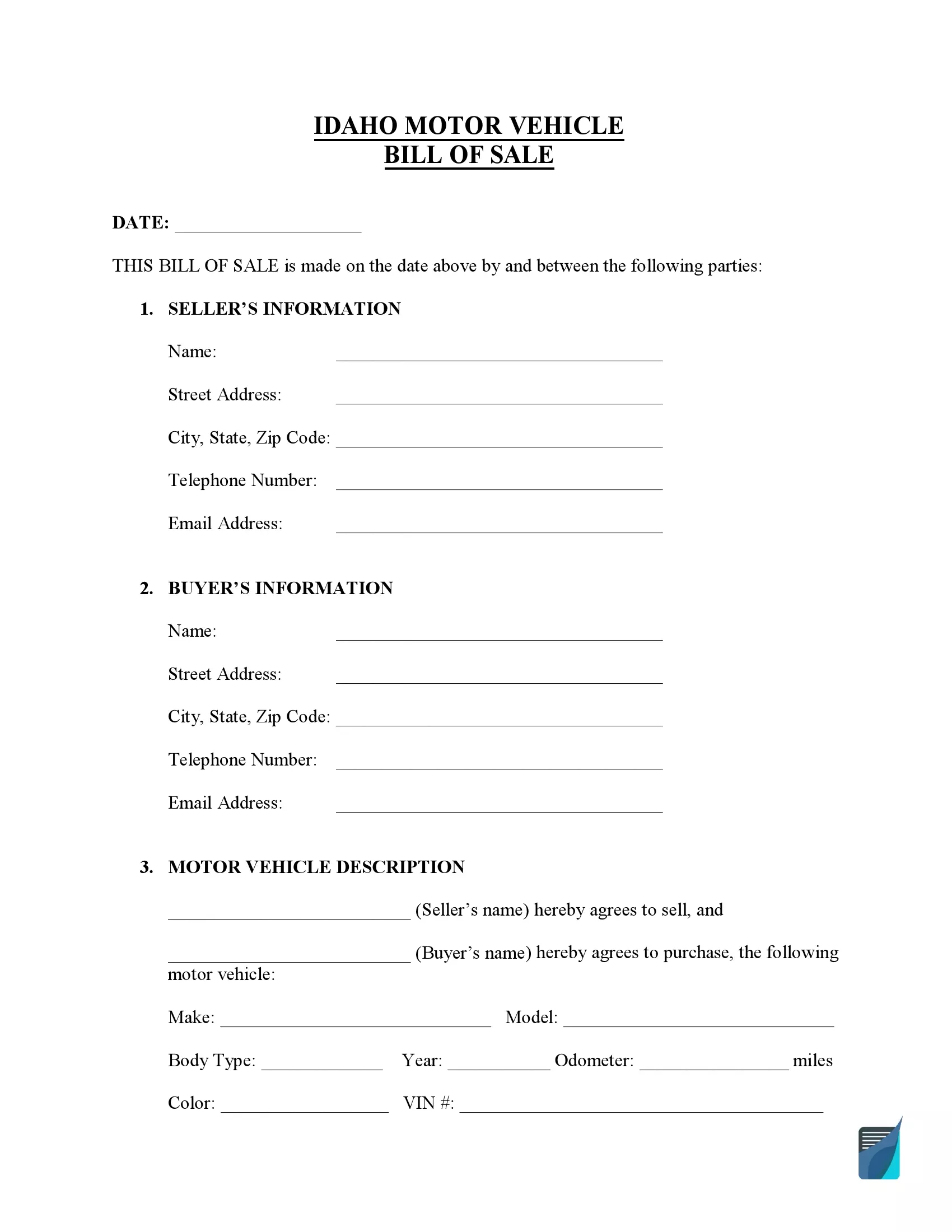
Build Your Document
Answer a few simple questions to make your document in minutes
Save and Print
Save progress and finish on any device, download and print anytime
Sign and Use
Your valid, lawyer-approved document is ready
Document Details
| Document Name | Idaho Vehicle Bill of Sale Form |
| Other Names | Idaho Car Bill of Sale, Idaho Automobile Bill of Sale |
| DMV | Idaho Transportation Department |
| Vehicle Registration Fee | $45-69 (electric car – $140 per year additionally) |
| Bill of Sale Required? | No |
| Avg. Time to Fill Out | 7 minutes |
| # of Fillable Fields | 42 |
Idaho Bill of Sale Forms by Type
For private transactions in Idaho, select from the existing templates of bills of sale that already have all the needed fields to fill in. You can choose from general forms to more specialized ones.

You will need an Idaho car bill of sale to sign in for the sale and purchase of motor vehicles. The form is needed as proof of a vehicle ownership change.
| Alternative Name | Car Bill of Sale |
| Seller’s Signature | Required |
| Buyer’s Signature | Required |
| Notarization | Optional |
| Download | PDF Template |
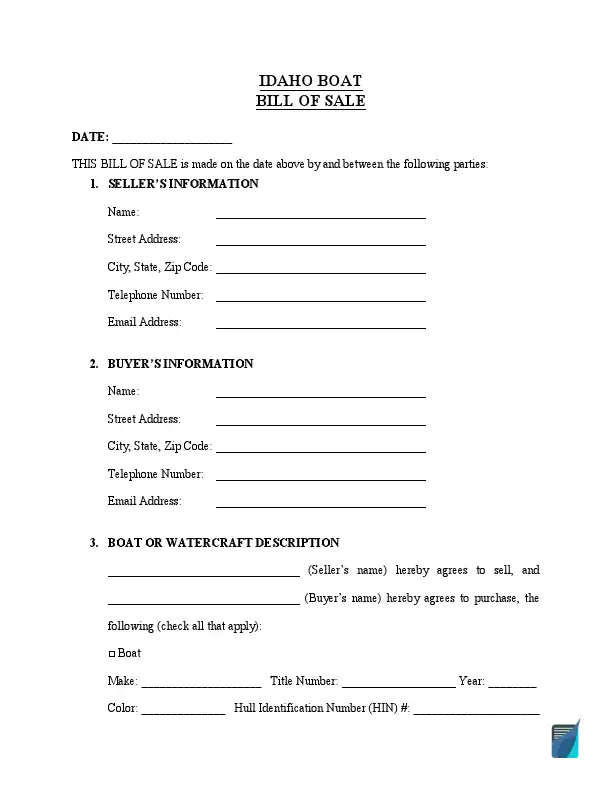
Idaho boat bill of sale proves your ownership of a new acquired vessel. It is needed to register a new vessel with the Idaho Department of Parks and Recreation. All vessels should have a Certificate Number.
| Alternative Name | Vessel Bill of Sale |
| Seller’s Signature | Required |
| Buyer’s Signature | Optional |
| Notarization | Optional |
| Download | PDF Template |
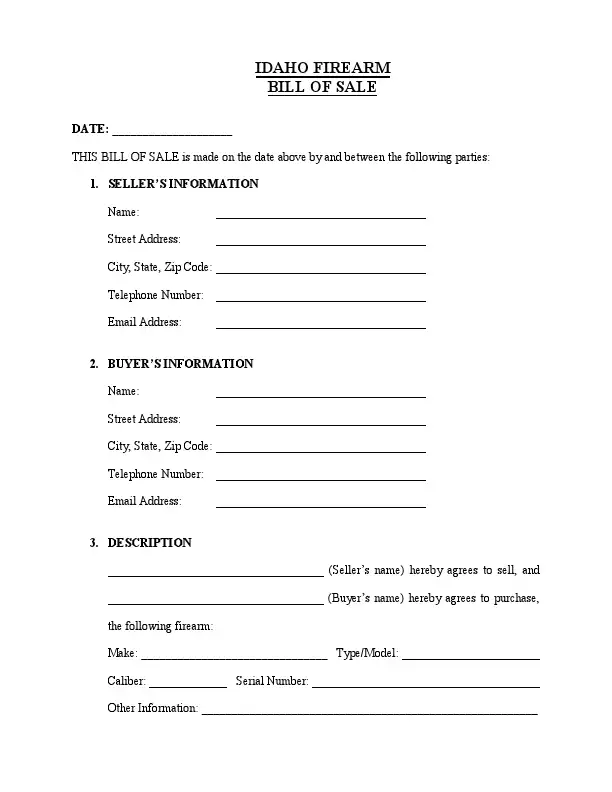
Use the Idaho gun bill of sale to make a purchase of a gun with a private owner. The form will serve as legal proof of transaction, even though the state law doesn’t require special registration or license for gun-carrying.
| Alternative Name | Gun Bill of Sale |
| Seller’s Signature | Required |
| Buyer’s Signature | Optional |
| Notarization | Optional |
| Download | PDF Template |
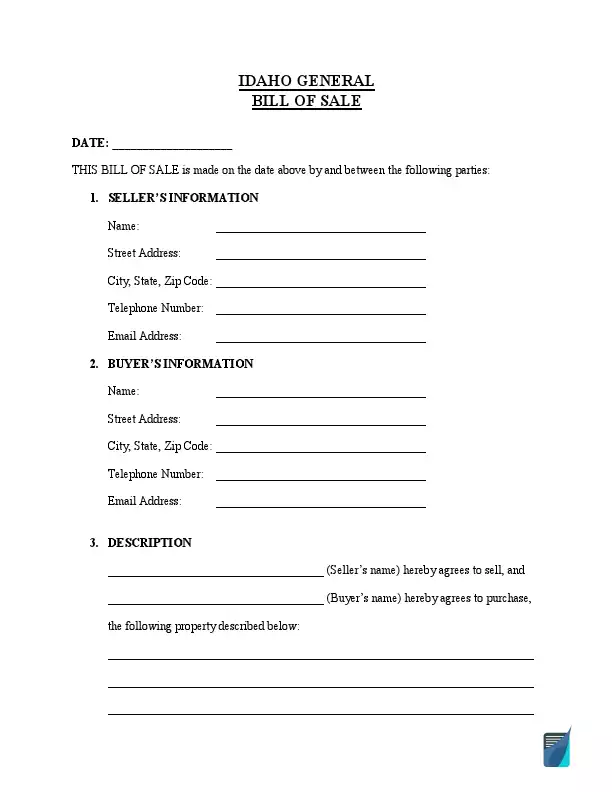
This general bill of sale template can be used for different types of transactions in the state of Idaho. This form is general and can be applicable to any type of transaction.
| Alternative Name | Generic Bill of Sale |
| Seller’s Signature | Required |
| Buyer’s Signature | Optional |
| Notarization | Optional |
| Download | PDF Template |
How to Write an ID Vehicle Bill of Sale
The Idaho DMV office offers Form ITD-3738 for vehicle transactions. Feel free to use a customized form if you want to add specific conditions. Otherwise, you’re encouraged to stick to an official template. Here are simple steps to take to complete this bill of sale form:
Step 1: Specify the information about the vehicle
Idaho’s official bill of sale form requires the seller to list all the details regarding the motor vehicle they sell. It’s necessary to mention:
- Vehicle Identification Number (1st)
- Vehicle Identification Number (2nd) for motor homes
- Title number
- Vehicle’s body style
- Year
- Make
- Model
- Complete vehicle description

Verify the information to avoid misspellings or errors, as the bill of sale may not be considered valid, having even minor mistakes.
Step 2: Indicate the vehicle’s brands (optional)
If the vehicle has been in any insurance incident and the vehicle’s title has been branded, don’t forget to notify the buyer about that. You will need to mention if the vehicle has been titled as reconstructed, rebuilt, or repaired.
![]()
Step 3: Provide an odometer reading statement
In this section, you will need to specify the vehicle’s actual mileage. Select the checkbox that is the truest to your case.

Step 4: Provide the seller’s contact details
In this section, you have to specify the following information about the seller:
- Full legal name
- Physical address (city, state, and zip code)
- Mailing address (city, state, and zip code)
- Phone number
You need to add the seller’s mailing address if it’s different from the physical address.
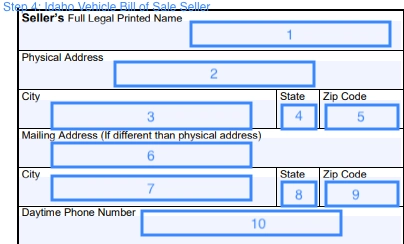
Step 5: Add the date and purchase price
The following step is to add the actual selling price and the date of the transaction.
![]()
Step 6: Fill out the buyer’s contact details
This section is devoted to the buyer. You need to specify all the relevant contact information, including:
- Full legal name
- Driver’s license number
- Physical address (city, state, and zip code)
- Mailing address (city, state, and zip code)
- Phone number
There is no need to write down the buyer’s mailing address if it’s the same as the physical address.
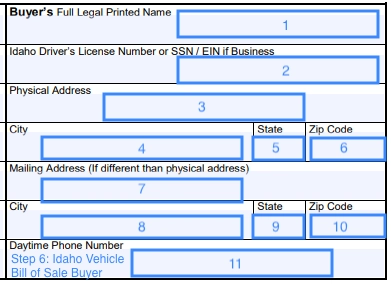
Step 7: Provide information about the new lienholder (optional)
If you opt for paying in part, you will need to specify the new lienholder’s information. You will have to provide the contact details of the lienholder, such as follows:
- Full name
- Street address
- City
- State
- Zip Code

Step 8: Provide the seller’s signature
The seller signs the document to certify the intent to sell the vehicle and verify that all information in the document is valid.

Step 9: Get the buyer’s signature
The last step is for the buyer to leave their signature as evidence that they acknowledge and agree with the terms of a deal.

You can additionally notarize a document to ensure its legality. However, it’s not a requirement, just an option. It functions as an additional way to safeguard against legal difficulties.
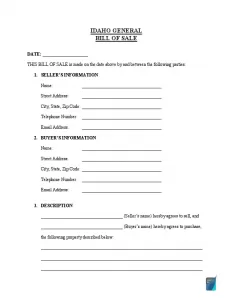
Registering a Vehicle in Idaho
Motor vehicle registration laws in Idaho require titling before duly registering a vehicle. It’s also possible to title and register a vehicle on the same day. However, the titling should precede the registration process. You can register your motor vehicle by visiting your nearest Idaho Department of Transportation offices across the state. You only have to present yourself in person to any of these offices with the relevant documents. File the following documents and meet these requirements to register a vehicle in Idaho:
- Complete an Application for Certificate of Title.
- If you want to register a motor vehicle from another state for the first time, the law requires you to complete a VIN form.
- Prepare a motor vehicle bill of sale as proof of ownership transfer.
- The law also requires you to produce a photo identification, which could be either a Driver’s License or State ID.
- Obtain a motor vehicle title.
- Get proof of motor vehicle insurance that meets each of Idaho’s legal requirements.
- Prepare yourself to pay all the stipulated fees before you complete your motor vehicle registration.
Besides the personal details an Idaho vehicle bill of sale contains about the buyer and seller, you will need to include the following information:
- VIN
- Title number
- Vehicle’s make, model, year of manufacture, weight, and width
The form should also include an odometer reading statement that proves the vehicle’s actual mileage. If the vehicle lacks an odometer, the bill should show if it exceeds its mechanical limits. It’s also mandatory for the bill of sale to show that the seller has agreed to sell the vehicle at a given date for a specific price. If the automobile has a lienholder, the document should also state their name and address.
The vendor should agree to give the buyer a release of liability statement within five days after selling the motor vehicle. The seller’s signature proves they understand that they will face felony charges if they give any false details on the bill. Thus, truthfulness and transparency are mandatory when filling this critical document. Moreover, the buyer should sign this document knowing that they should apply for the vehicle’s title within 30 days. Otherwise, they will be penalized for late application.
Relevant Official Forms
Power of Attorney gives another individual temporary legal rights to handle vehicle-related procedures required by Idaho DMV.
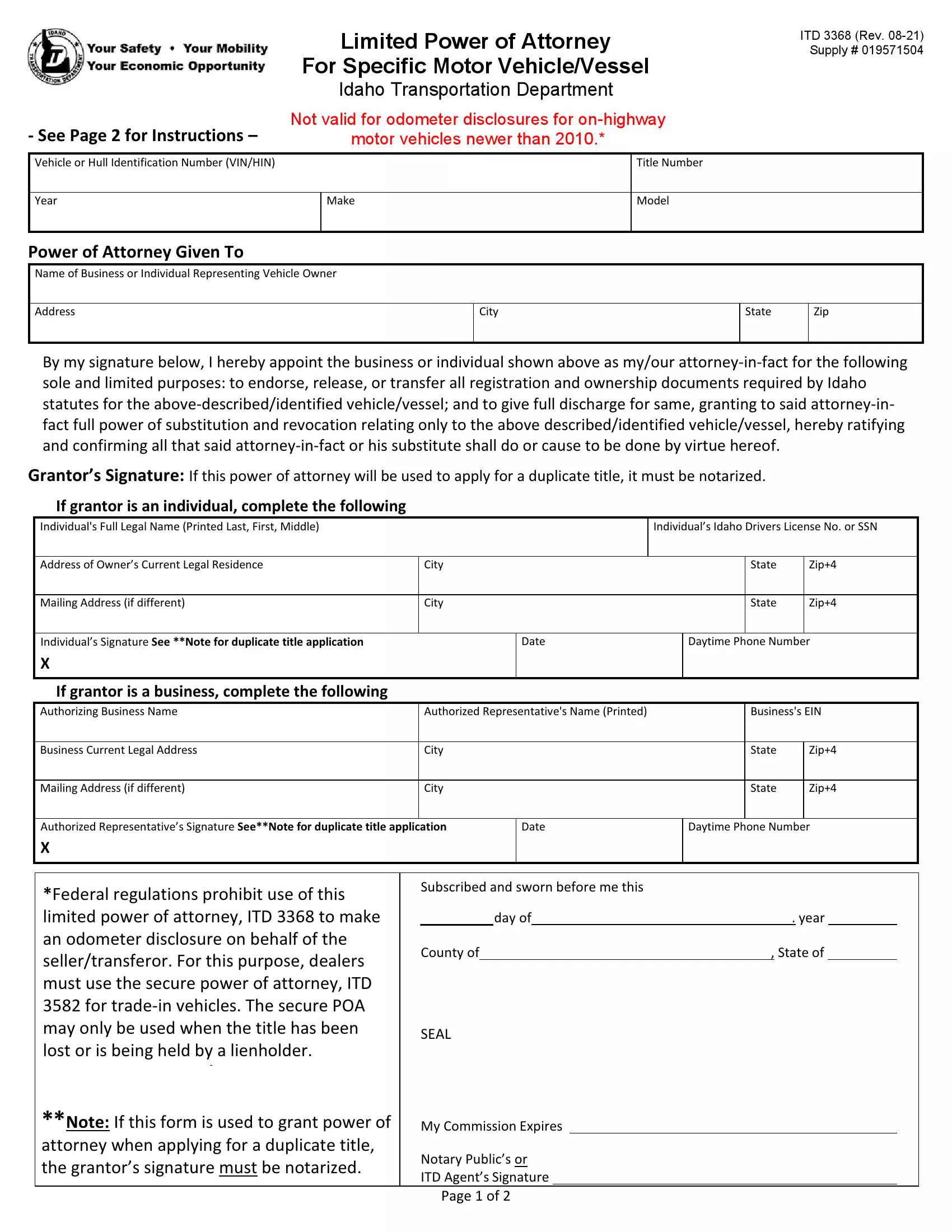
Affidavit of Inheritance/Small Estate is submitted when the ownership is transferred to the heir upon the death of the previous title owner.
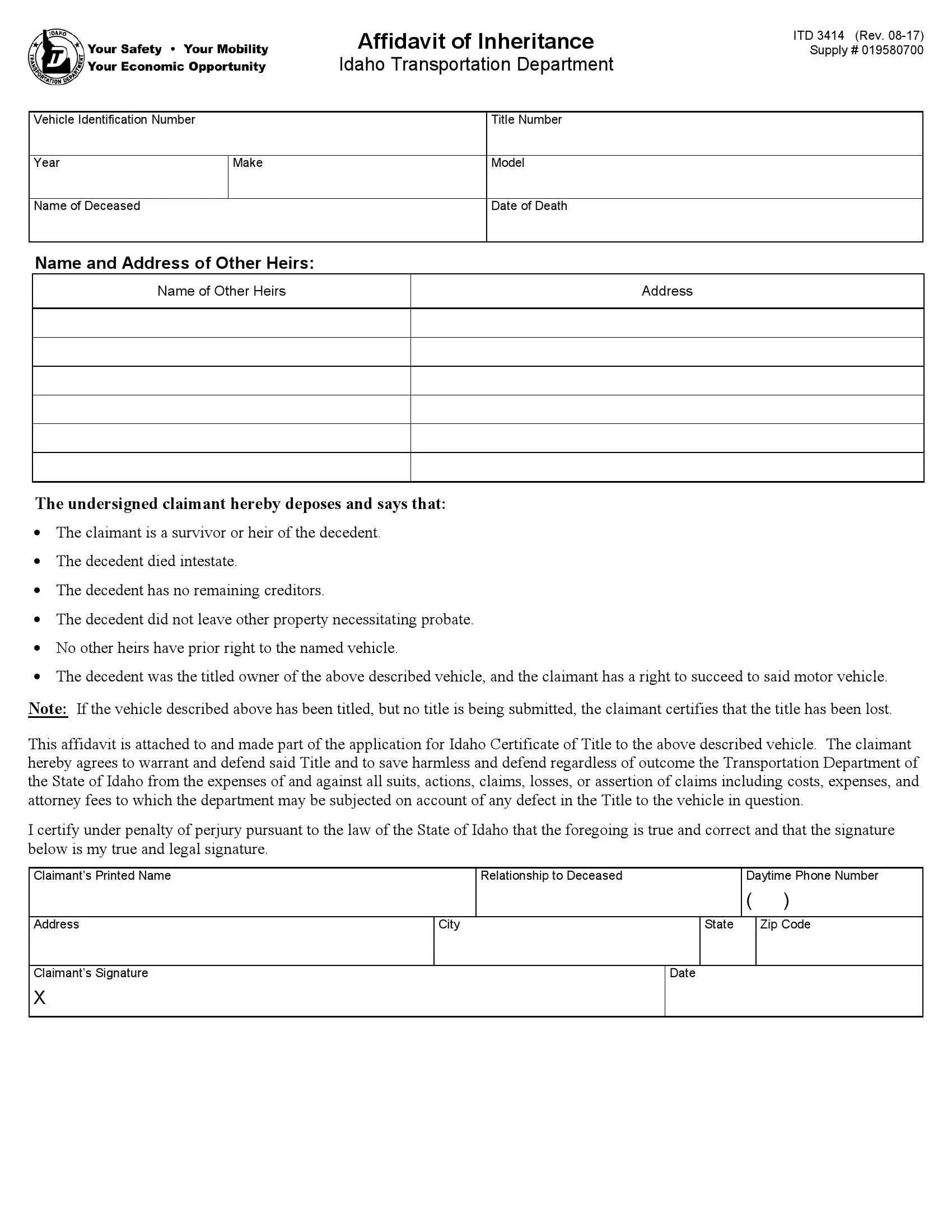
Indemnifying Affidavit is reqired when you apply for a vessel title that was acquired prior to January 1, 2000.
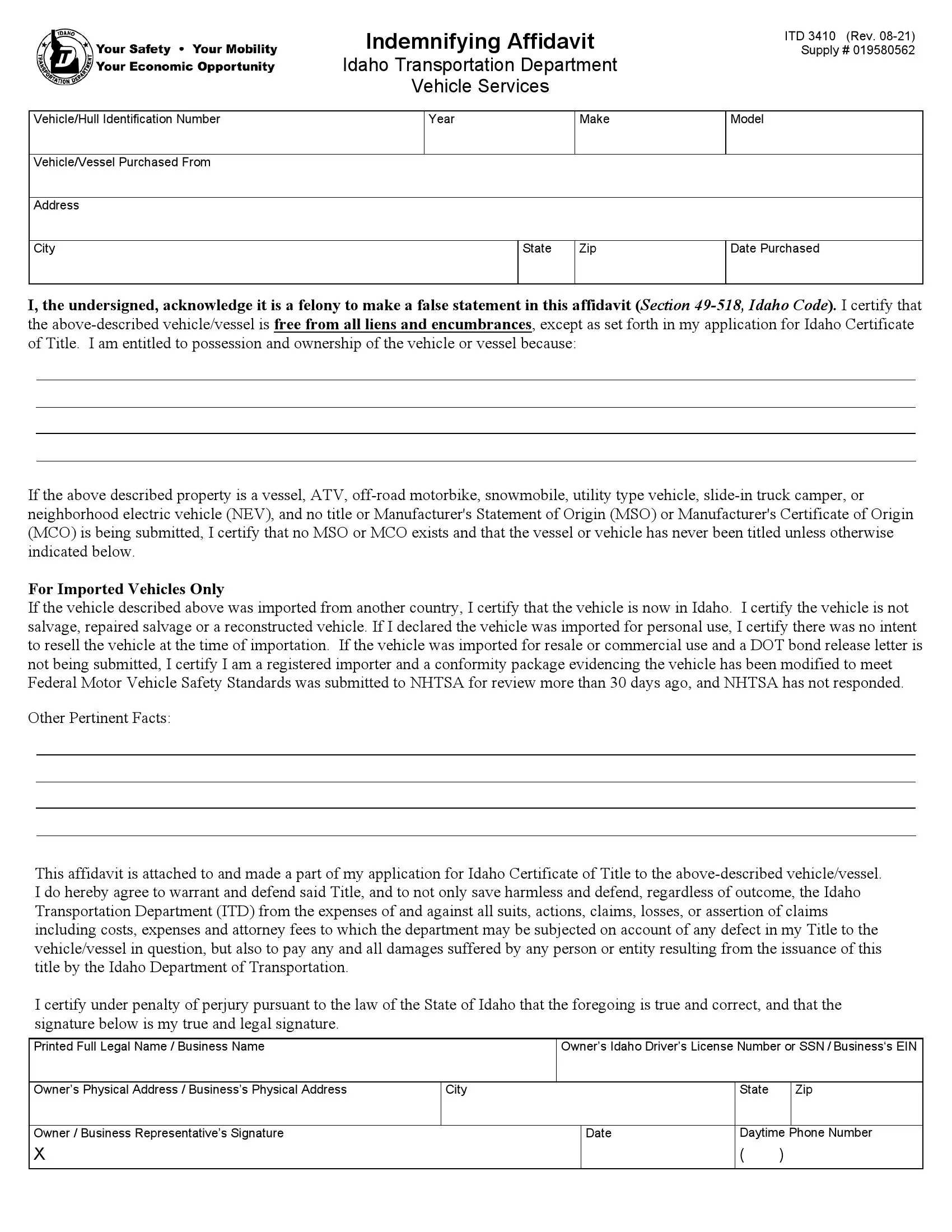
Release of interest is a form that accompanies a bill of sale, which the applicant must submit to get a vessel registration.
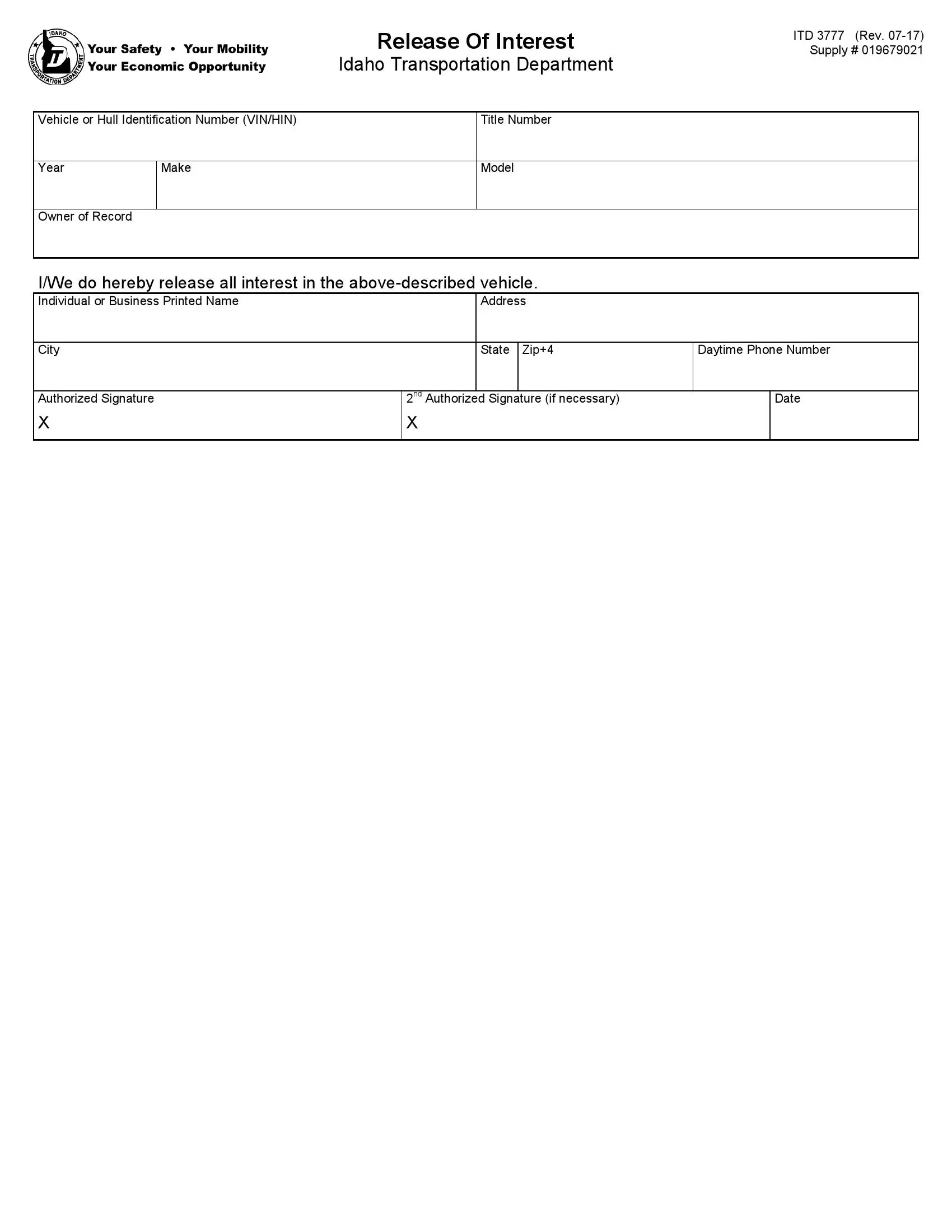
The concealed weapons license application is for all residents who want a permit to carry a concealed firearm within Idaho state.
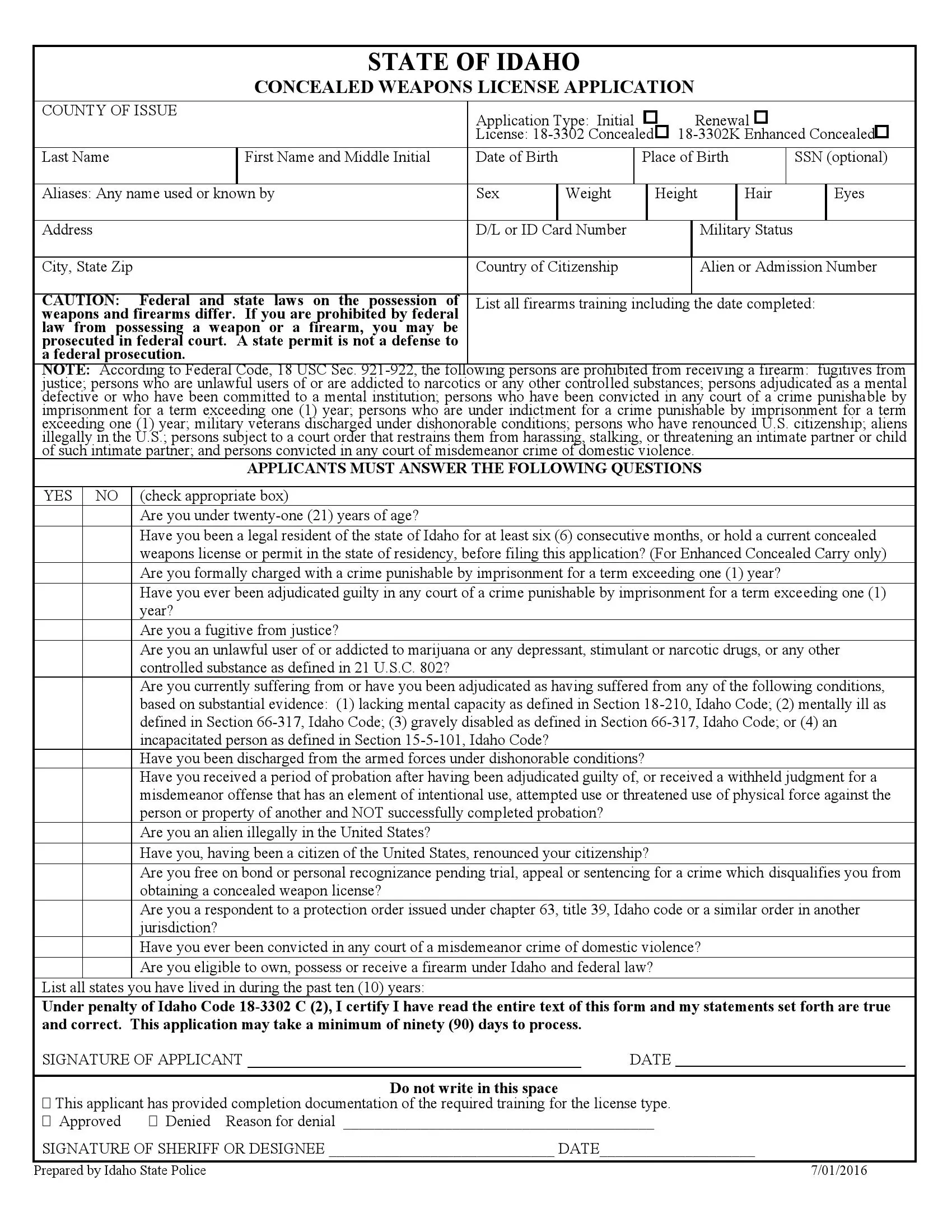
Short Idaho Bill of Sale Video Guide

Other Bill of Sale Forms by State

